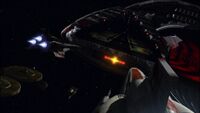Hands-on approach: Difference between revisions
m (reconciled reference to screen capture shown) |
No edit summary |
||
| Line 10: | Line 10: | ||
Commander Adama has banned the use of auto-landing systems aboard ''Galactica'', probably because it would involve the networking of computers that would send data to a ship's autopilot and guide it in for an automatic landing. Commander Adama had maintained (or renewed) the policy of non-networked computers on ''Galactica'' in the event of a new Cylon attack. Such automatic systems could be easily infiltrated by Cylon [[Cylon computer virus|viruses]] (a tactic used in the first [[Cylon War]]). | Commander Adama has banned the use of auto-landing systems aboard ''Galactica'', probably because it would involve the networking of computers that would send data to a ship's autopilot and guide it in for an automatic landing. Commander Adama had maintained (or renewed) the policy of non-networked computers on ''Galactica'' in the event of a new Cylon attack. Such automatic systems could be easily infiltrated by Cylon [[Cylon computer virus|viruses]] (a tactic used in the first [[Cylon War]]). | ||
A typical [[wireless]] | A typical [[wireless]] exchange for a hands-on approach between [[LSO|Landing Signal Officer]] and pilot might go like this: | ||
:'''LSO:''' " | :'''LSO:''' "Viper seven niner one Galactica, you are cleared for approach ... Speed one seven five, port bay, hands-on approach, checker's green, call the ball<ref>The "ball" refers to the arrangement of crossed navigational lights at the lip of the [[landing bay]], and/or the visual cue on a cockpit display (as seen in [[Louanne Katraine|Kat's]] Viper in "[[Act of Contrition]]"). The pilot would use this to adjust his/her glideslope for a proper approach into the flight pod. The phrase "I have the ball" informs the LSO that the pilot has acquired this visual cue and is beginning the final approach. This is consistent with Ron Moore's parallels to real-world naval terminology; an actual "ball" is a fresnel-lensed lamp that a pilot would see as a floating light against a reference line (called a "datum"), which would show the pilot if he/she was over or under the proper glideslope path.</ref>." | ||
:''' | :'''Pilot:''' "Copy. I have the ball<ref>On a technical note, Colonial Fleet procedure is the reverse of the real-world one; the pilot tells the LSO when he/she is ready (lined up and sees the ball), and the LSO responds that he/she is ready to guide the pilot in: ''' | ||
:Pilot: "Seven niner one, Viper, ball, (fuel remaining), (callsign)." | |||
:LSO: "Roger ball." ''' | |||
This dialogue would sound cryptic to the uninitiated, so dramatic license with procedure is fitting.</ref>." | |||
== References == | == References == | ||
Revision as of 07:18, 14 August 2007

Since landing on a battlestar is a very difficult feat requiring much practice, it seems that almost all battlestars opted to make landings easier through a series of computers that form an auto-landing system. Before the surprise Cylon Attack, the two choices to land on a typical battlestar were by automatic landing or a hands-on approach, meaning a manually controlled landing.

On Galactica, a hands-on landing is the only accepted landing procedure, as per William Adama's orders. The policy confuses Lee Adama when he is instructed to land his Viper Mk. VII manually (Miniseries).
There are two kinds of hands-on approaches: the condition three-mode landing preformed by Lee Adama when first arriving on Galactica (Miniseries), or a high-speed combat landing into the flight pod.
Commander Adama has banned the use of auto-landing systems aboard Galactica, probably because it would involve the networking of computers that would send data to a ship's autopilot and guide it in for an automatic landing. Commander Adama had maintained (or renewed) the policy of non-networked computers on Galactica in the event of a new Cylon attack. Such automatic systems could be easily infiltrated by Cylon viruses (a tactic used in the first Cylon War).
A typical wireless exchange for a hands-on approach between Landing Signal Officer and pilot might go like this:
- LSO: "Viper seven niner one Galactica, you are cleared for approach ... Speed one seven five, port bay, hands-on approach, checker's green, call the ball[1]."
- Pilot: "Copy. I have the ball[2]."
References
- ↑ The "ball" refers to the arrangement of crossed navigational lights at the lip of the landing bay, and/or the visual cue on a cockpit display (as seen in Kat's Viper in "Act of Contrition"). The pilot would use this to adjust his/her glideslope for a proper approach into the flight pod. The phrase "I have the ball" informs the LSO that the pilot has acquired this visual cue and is beginning the final approach. This is consistent with Ron Moore's parallels to real-world naval terminology; an actual "ball" is a fresnel-lensed lamp that a pilot would see as a floating light against a reference line (called a "datum"), which would show the pilot if he/she was over or under the proper glideslope path.
- ↑ On a technical note, Colonial Fleet procedure is the reverse of the real-world one; the pilot tells the LSO when he/she is ready (lined up and sees the ball), and the LSO responds that he/she is ready to guide the pilot in:
- Pilot: "Seven niner one, Viper, ball, (fuel remaining), (callsign)."
- LSO: "Roger ball."